#Image credit: NASA/JPL/Space Science Institute
Explore tagged Tumblr posts
Text
The celestial object of the day is Prometheus!
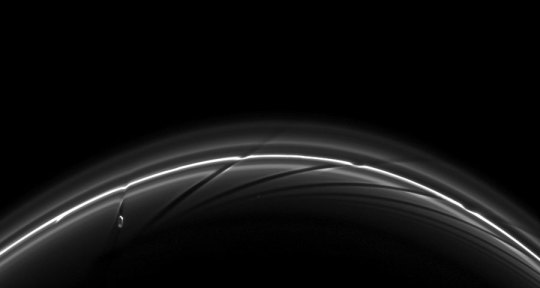
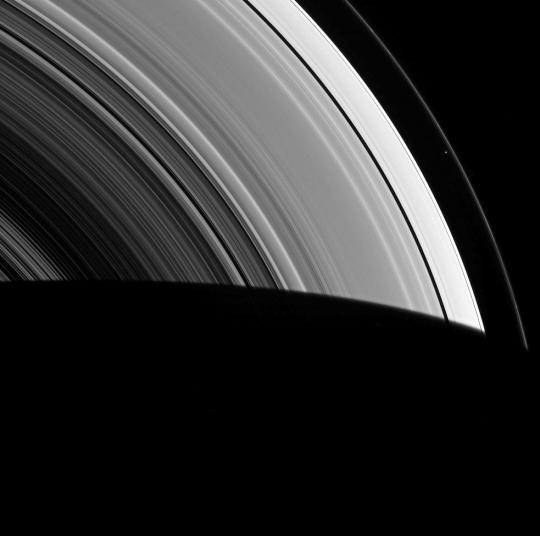
This shepherd moon (a moon that thanks to its gravitational influence helps to hold the planet's rings) generates "ring streamers" when it's closest to said ring by pulling material to itself (as shown in the first photo).
#Image credit: NASA/JPL/Space Science Institute#GUESS WHO'S BACK!!#International moon day is close so I had to come back#I'll try to be more active but I don't promise anything lmao#In the draft of this post I didn't clarify if it was Prometheus the moon or Prometheus the satellite#Hope I got the right one lmao#astronomy facts#astrophotography#astronomy#outer space#space#space exploration#space photography#astrophysics#nasa#prometheus#Prometheus moon#saturn#saturn's moons#astronomy photography#Cassini-Huygens#Celestial object of the day#I said ring so many times...
46 notes
·
View notes
Photo
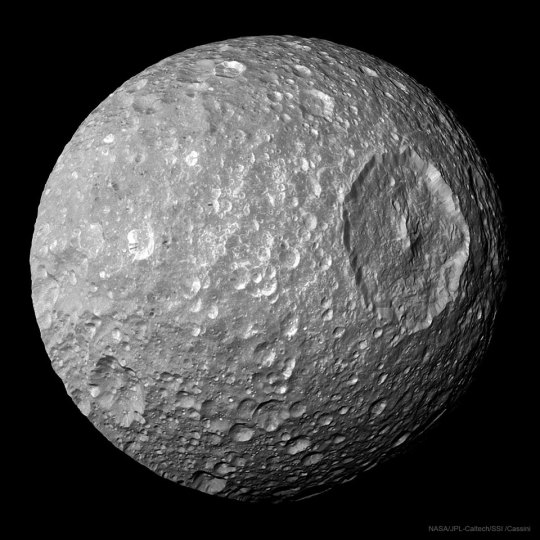
2025 January 12
Mimas: Small Moon with a Big Crater Image Credit: NASA, JPL-Caltech, Space Science Institute, Cassini
Explanation: Whatever hit Mimas nearly destroyed it. What remains is one of the largest impact craters on one of Saturn's smallest round moons. Analysis indicates that a slightly larger impact would have destroyed Mimas entirely. The huge crater, named Herschel after the 1789 discoverer of Mimas, Sir William Herschel, spans about 130 kilometers and is featured here. Mimas' low mass produces a surface gravity just strong enough to create a spherical body but weak enough to allow such relatively large surface features. Mimas is made of mostly water ice with a smattering of rock - so it is accurately described as a big dirty snowball. The featured image was taken during the closest-ever flyby of the robot spacecraft Cassini past Mimas in 2010 while in orbit around Saturn.
∞ Source: apod.nasa.gov/apod/ap250112.html
201 notes
·
View notes
Text
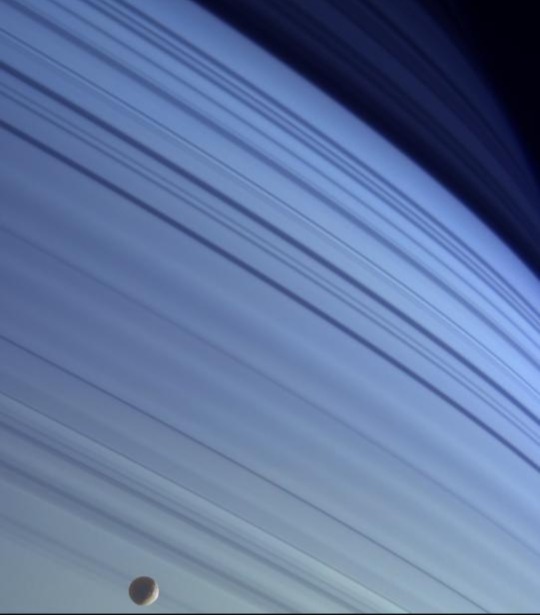
Saturn's little moon Mimas gliding against Saturn's blue, relatively cloudless atmosphere, and the rings' shadows. Image by the Cassini orbiter, 2005
Image Credit: NASA/JPL/Space Science Institute
#mimas#saturn#saturn rings#satty and the moonies#cassini spacecraft#cassini orbiter#cassini#astronomy#space#outer space#solar system#cosmos#nasa#esa#planets#space exploration#space images#space is cool
71 notes
·
View notes
Text
Playful Martian Dust Devils

The Martian atmosphere lacks the density to support tornado storm systems, but vortices are nevertheless a frequent occurrence. As sun-warmed gases rise, neighboring air rushes in, bringing with it any twisted shred of vorticity it carries. (Video and image credit: NASA/JPL-Caltech/LANL/CNES/CNRS/INTA-CSIC/Space Science Institute/ISAE-Supaero/University of Arizona; via Gizmodo) Read the full article
#atmospheric science#conservation of angular momentum#dust devils#fluid dynamics#Mars#physics#science#vorticity
79 notes
·
View notes
Photo

nasa: A stone cold look at Saturn 🗿
The giant planet gives us a look into its moody disposition. The Cassini spacecraft captured this image on Jan. 30, 2007, from a distance of 700,000 miles (1.1 million kilometers). As Saturn’s atmosphere rages with thunderous and hurricane-like storms, its majestic rings spin a tale of ancient collisions and cataclysms. A joint endeavor of NASA, @europeanspaceagency, and @agenziaspazialeitaliana, Cassini was a sophisticated robotic spacecraft sent to study Saturn and its complex system of rings and moons over the course of a decade. Lessons we took from Cassini helped in the planning of our #EuropaClipper mission, which is on its way to Jupiter and expected to arrive in April 2030. Image description: A black-and-white image of Saturn taken from a lower angle. The rings of Saturn frame the upper right portion of the planet in various widths. Details of stripes and swirls from storms can be seen along the face of the planet. The left side of the planet is encompassed in a shadow. Credit: NASA/JPL-Caltech/Space Science Institute #NASA #Space #Saturn #Rings #Storms #Atmosphere #Moody #Planet #SolarSystem #BlackAndWhite
#nasa#esa#asi#space#saturn#cassini#jpl#jpl-caltech#cal tech#space science institute#planet#rings#storm#atmosphere#solar system#astronomy#space exploration#2007#january 30
64 notes
·
View notes
Text
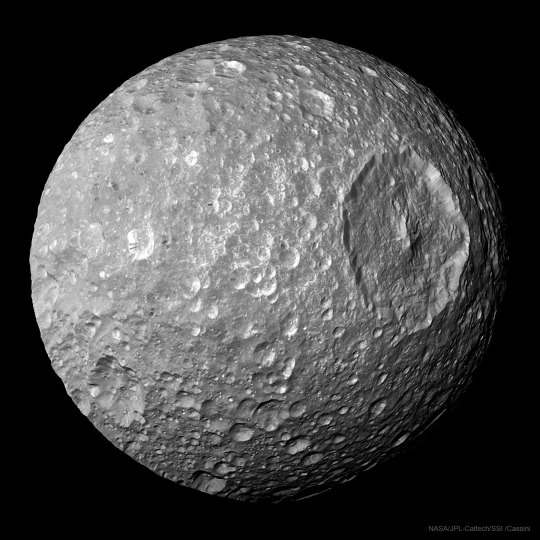
"Mimas"
Image Credit: NASA, JPL-Caltech, Space Science Institute, Cassini
#art#cosmos#cosmic#universe#blast#space#photography#mimas#crater#starwars#death star#NASA#IPL-Caltech#cassini
37 notes
·
View notes
Text
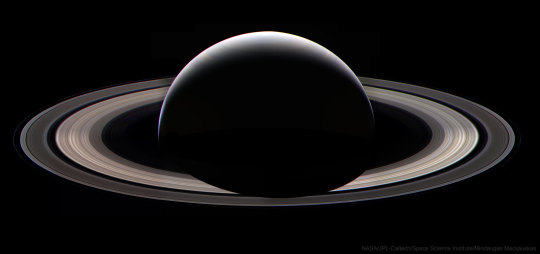
Saturn.
Image Credit: NASA, JPL-Caltech, Space Science Institute, Mindaugas Macijauskas
#space#science#nature#astronomy#Universe#Cosmos#Astrophotography#NASA#astro community#outer space#astrophysics#cosmology#solar system#saturn#planets
40 notes
·
View notes
Text

Titan’s mysterious wobbling atmosphere
The puzzling behaviour of Titan’s atmosphere has been revealed by researchers at the University of Bristol for the first time.
By analysing data from the Cassini-Huygens mission, a joint venture between NASA, the European Space Agency (ESA), and the Italian Space Agency, the team have shown that the thick, hazy atmosphere of Saturn’s largest moon doesn’t spin in line with its surface, but instead wobbles like a gyroscope, shifting with the seasons.
Titan is the only moon in the Solar System with a significant atmosphere, and one that has long captivated planetary scientists. Now, after 13 years of thermal infrared observations from Cassini, researchers have tracked how Titan’s atmosphere tilts and shifts over time.
“The behaviour of Titan’s atmospheric tilt is very strange!” said Lucy Wright, lead author and postdoctoral researcher at Bristol’s School of Earth Sciences. “Titan’s atmosphere appears to be acting like a gyroscope, stabilising itself in space.
“We think some event in the past may have knocked the atmosphere off its spin axis, causing it to wobble.
“Even more intriguingly, we’ve found that the size of this tilt changes with Titan’s seasons.”
The team studied the symmetry of Titan’s atmospheric temperature field and found that it isn’t centred exactly on the pole, as expected. Instead, it shifts over time, in step with Titan’s long seasonal cycle—each year on Titan lasts nearly 30 years on Earth.
Professor Nick Teanby, co-author and planetary scientist at Bristol said: “What’s puzzling is how the tilt direction remains fixed in space, rather than being influenced by the Sun or Saturn.
“That would’ve given us clues to the cause. Instead, we’ve got a new mystery on our hands.”
This discovery will impact NASA’s upcoming Dragonfly mission, a drone-like rotorcraft scheduled to arrive at Titan in the 2030s. As Dragonfly descends through the atmosphere, it will be carried by Titan’s fast-moving winds—winds that are about 20 times faster than the rotation of the surface.
Understanding how the atmosphere wobbles with the seasons is crucial for calculating the landing trajectory of Dragonfly. The tilt affects how the payload will be carried through the air, so this research can help engineers better predict where it will touch down.
Dr Conor Nixon, planetary scientist at NASA Goddard and co-author of the study, added: “Our work shows that there are still remarkable discoveries to be made in Cassini’s archive.
“This instrument, partly built in the UK, journeyed across the Solar System and continues to give us valuable scientific returns.
“The fact that Titan’s atmosphere behaves like a spinning top disconnected from its surface raises fascinating questions—not just for Titan, but for understanding atmospheric physics more broadly, including on Earth.”
The team’s findings contribute to a growing body of research suggesting Titan is not just Earth-like in appearance but an alien world with climate systems all its own, and many secrets still hidden beneath its golden haze.
TOP IMAGE: Purple haze around Titan – A false-colour image of Titan captured in 2004 by the Cassini spacecraft. The purple haze shows the dense atmosphere enveloping the moon’s golden body. Credit NASA/JPL/Space Science Institute.
LOWER IMAGE: The wobble of Titan’s atmosphere. The atmosphere is tilted relative to Titan’s solid body, and this tilt varies in size and direction Credit Titan image credit: NASA/JPL/Space Science Institute Diagram by Lucy Wright

9 notes
·
View notes
Text
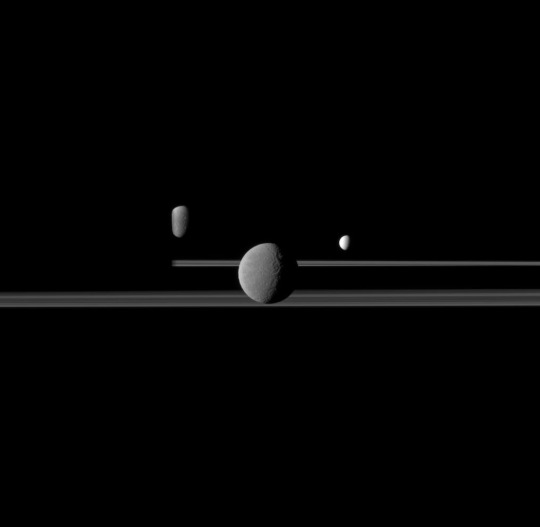
The Cassini spacecraft observes three of Saturn's moons set against the darkened night side of the planet.
Image Credit: NASA/JPL/Space Science Institute
3 notes
·
View notes
Link
The mission team of NASA’s Jupiter-orbiting Juno spacecraft executed a deep-space move in December 2023 to repair its JunoCam imager to capture photos of the Jovian moon Io. Results from the long-distance save were presented during a technical session on July 16 at the Institute of Electrical and Electronics Engineers Nuclear & Space Radiation Effects Conference in Nashville.JunoCam is a color, visible-light camera. The optical unit for the camera is located outside a titanium-walled radiation vault, which protects sensitive electronic components for many of Juno’s engineering and science instruments. The graininess and horizontal lines seen in this JunoCam image show evidence that the camera aboard NASA’s Juno mission suffered radiation damage. The image, which captures one of the circumpolar cyclones on Jupiter’s north pole, was taken Nov. 22, 2023. Credit: NASA/JPL-Caltech/SwRI/MSSS This is a challenging location because Juno’s travels carry it through the most intense planetary radiation fields in the solar system. While mission designers were confident JunoCam could operate through the first eight orbits of Jupiter, no one knew how long the instrument would last after that.Throughout Juno’s first 34 orbits (its prime mission), JunoCam operated normally, returning images the team routinely incorporated into the mission’s science papers. Then, during its 47th orbit, the imager began showing hints of radiation damage. By orbit 56, nearly all the images were corrupted.Long Distance Microscopic RepairWhile the team knew the issue may be tied to radiation, pinpointing what, specifically, was damaged within JunoCam was difficult from hundreds of millions of miles away. Clues pointed to a damaged voltage regulator that is vital to JunoCam’s power supply. With few options for recovery, the team turned to a process called annealing, where a material is heated for a specified period before slowly cooling. Although the process is not well understood, the idea is that the heating can reduce defects in the material. “We knew annealing can sometimes alter a material like silicon at a microscopic level but didn’t know if this would fix the damage,” said JunoCam imaging engineer Jacob Schaffner of Malin Space Science Systems in San Diego, which designed and developed JunoCam and is part of the team that operates it. “We commanded JunoCam’s one heater to raise the camera’s temperature to 77 degrees Fahrenheit — much warmer than typical for JunoCam — and waited with bated breath to see the results.”Soon after the annealing process finished, JunoCam began cranking out crisp images for the next several orbits. But Juno was flying deeper and deeper into the heart of Jupiter’s radiation fields with each pass. By orbit 55, the imagery had again begun showing problems.“After orbit 55, our images were full of streaks and noise,” said JunoCam instrument lead Michael Ravine of Malin Space Science Systems. “We tried different schemes for processing the images to improve the quality, but nothing worked. With the close encounter of Io bearing down on us in a few weeks, it was Hail Mary time: The only thing left we hadn’t tried was to crank JunoCam’s heater all the way up and see if more extreme annealing would save us.” Test images sent back to Earth during the annealing showed little improvement the first week. Then, with the close approach of Io only days away, the images began to improve dramatically. By the time Juno came within 930 miles (1,500 kilometers) of the volcanic moon’s surface on Dec. 30, 2023, the images were almost as good as the day the camera launched, capturing detailed views of Io’s north polar region that revealed mountain blocks covered in sulfur dioxide frosts rising sharply from the plains and previously uncharted volcanos with extensive flow fields of lava.Testing LimitsTo date, the solar-powered spacecraft has orbited Jupiter 74 times. Recently, the image noise returned during Juno’s 74th orbit.Since first experimenting with JunoCam, the Juno team has applied derivations of this annealing technique on several Juno instruments and engineering subsystems.“Juno is teaching us how to create and maintain spacecraft tolerant to radiation, providing insights that will benefit satellites in orbit around Earth,” said Scott Bolton, Juno’s principal investigator from the Southwest Research Institute in San Antonio. “I expect the lessons learned from Juno will be applicable to both defense and commercial satellites as well as other NASA missions.”More About JunoNASA’s Jet Propulsion Laboratory, a division of Caltech in Pasadena, California, manages the Juno mission for the principal investigator, Scott Bolton, of the Southwest Research Institute in San Antonio. Juno is part of NASA’s New Frontiers Program, which is managed at NASA’s Marshall Space Flight Center in Huntsville, Alabama, for the agency’s Science Mission Directorate in Washington. The Italian Space Agency, Agenzia Spaziale Italiana, funded the Jovian InfraRed Auroral Mapper. Lockheed Martin Space in Denver built and operates the spacecraft. Various other institutions around the U.S. provided several of the other scientific instruments on Juno.More information about Juno is at:https://www.nasa.gov/juno
3 notes
·
View notes
Text
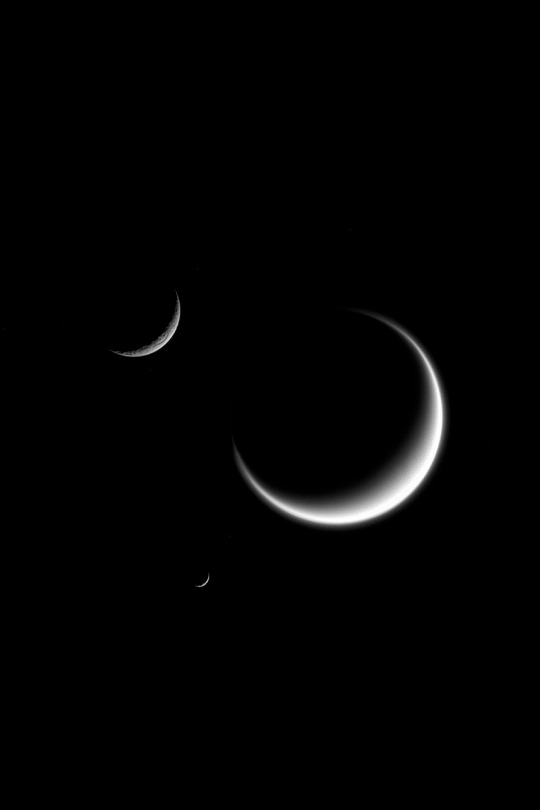
Triple Crescents of Saturn | This image was taken by the Cassini-Huygens project in 2015. It shows three of Saturn's moons: Titan (largest), Rhea and Mimas (smallest). It is thought that Saturn has approximately 146 moons with confirmed orbits. Photography credit: NASA/JPL-Caltech/Space Science Institute.
#saturn#space#titan#rhea#mimas#space is so cool#how do i quit my current job and do space as my real job#astronomy#moon#planet#black and white
88 notes
·
View notes
Text
The celestial object of the day is Mimas!


This saturnian moon has a crater named the Herschel Crater, the second biggest of any planetary moon, measuring 139 km (86 mi) in diameter. Mimas has so many craters that new ones can only form inside existing ones
#Image credit: NASA/JPL/Space Science Institute#If you were wondering...#the biggest crater in the solar system is the Odysseus crater in Thetys#almost four times bigger than Herschel#Aaaaand fun fact: mimas has a water ocean 20-30 km (12 - 19 mi) beneath its surface#Finding a pretty picture of Mimas is hard#Like#I love Mimas but it's just so ugly 😭😭#End of yapping#astronomy#astrophotography#outer space#space#nasa#nasa photos#science#space exploration#space photography#Celestial object of the day#mimas#saturn#saturn rambles#Moons#saturn's moons#Crater
60 notes
·
View notes
Photo
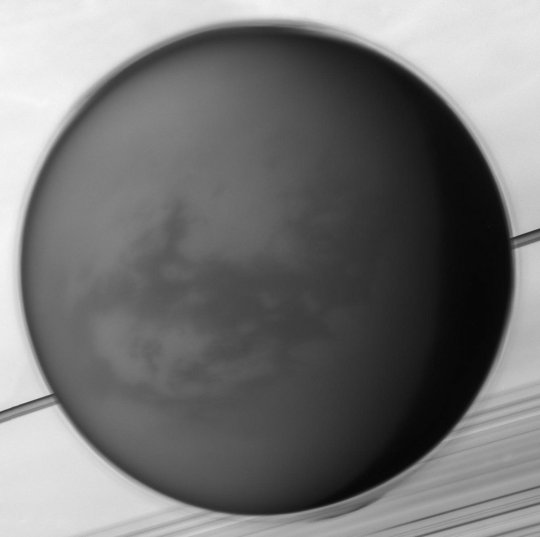
2025 May 3
Titan: Moon over Saturn Image Credit: NASA, JPL-Caltech, Space Science Institute
Explanation: Like Earth's moon, Saturn's largest moon Titan is locked in synchronous rotation with its planet. This mosaic of images recorded by the Cassini spacecraft in May of 2012 shows its anti-Saturn side, the side always facing away from the ringed gas giant. The only moon in the solar system with a dense atmosphere, Titan is the only solar system world besides Earth known to have standing bodies of liquid on its surface and an earthlike cycle of liquid rain and evaporation. Its high altitude layer of atmospheric haze is evident in the Cassini view of the 5,000 kilometer diameter moon over Saturn's rings and cloud tops. Near center is the dark dune-filled region known as Shangri-La. The Cassini-delivered Huygens probe rests below and left of center, after the most distant landing for a spacecraft from Earth.
∞ Source: apod.nasa.gov/apod/ap250503.html
62 notes
·
View notes
Text
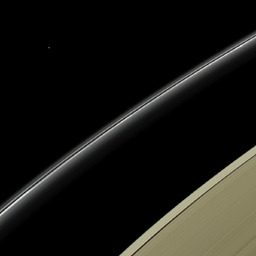
Uranus seen from Saturn as the pale blue orb in the dark. Cassini spacecraft image.
Image Credit: NASA/JPL-Caltech/Space Science Institute
#saturn#uranus#planet uranus#cassini spacecraft#cassini orbiter#cassini#saturn rings#pale blue dot#nasa#esa#nasa jpl#space science#space exploration#planets#outer space#cosmos#solar system#space#astronomy#space photography#space is cool
17 notes
·
View notes
Text
Slipping Along Enceladus

Home to a sub-surface ocean, Saturn's moon Enceladus is a fascinating candidate for life in our solar system. As it orbits Saturn, plumes periodically shoot out long surface features known as tiger stripes that sit near the icy moon's southern pole. A recent study, based on numerical simulation, suggests a geophysical mechanism that could account for the plumes. (Image credit: top - NASA/JPL-Caltech/Space Science Institute, illustration - A. Berne et al.; research credit: A. Berne et al.; via Gizmodo) Read the full article
#Enceladus#fluid dynamics#geophysics#numerical simulation#physics#plumes#Saturn#science#strike-slip fault
94 notes
·
View notes
Text
Astronomy Picture of the Day
2025 January 12
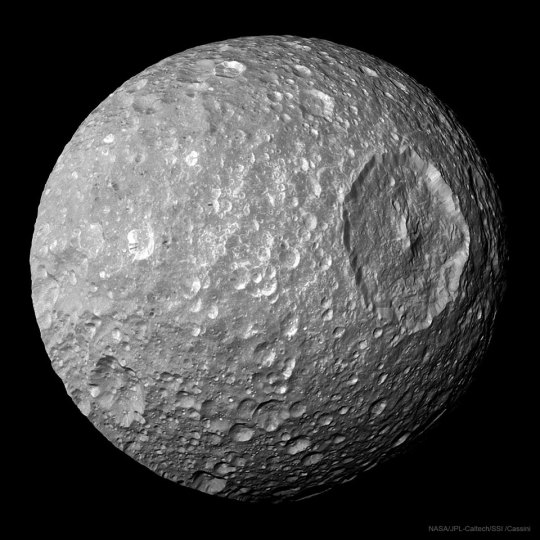
Mimas: Small Moon with a Big Crater
A cratered object is shown that shows on really large crater on its right side.
Image Credit: NASA, JPL-Caltech, Space Science Institute, Cassini
Whatever hit Mimas nearly destroyed it. What remains is one of the largest impact craters on one of Saturn's smallest round moons. Analysis indicates that a slightly larger impact would have destroyed Mimas entirely. The huge crater, named Herschel after the 1789 discoverer of Mimas, Sir William Herschel, spans about 130 kilometers and is featured here. Mimas' low mass produces a surface gravity just strong enough to create a spherical body but weak enough to allow such relatively large surface features. Mimas is made of mostly water ice with a smattering of rock - so it is accurately described as a big dirty snowball. The featured image was taken during the closest-ever flyby of the robot spacecraft Cassini past Mimas in 2010 while in orbit around Saturn.
Authors & editors: Robert Nemiroff (MTU) & Jerry Bonnell (UMCP)
NASA Official: Amber Straughn
A service of: ASD at NASA / GSFC,
NASA Science Activation
& Michigan Tech. U.
4 notes
·
View notes